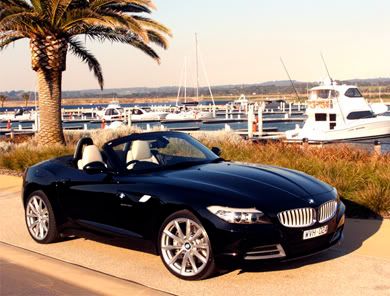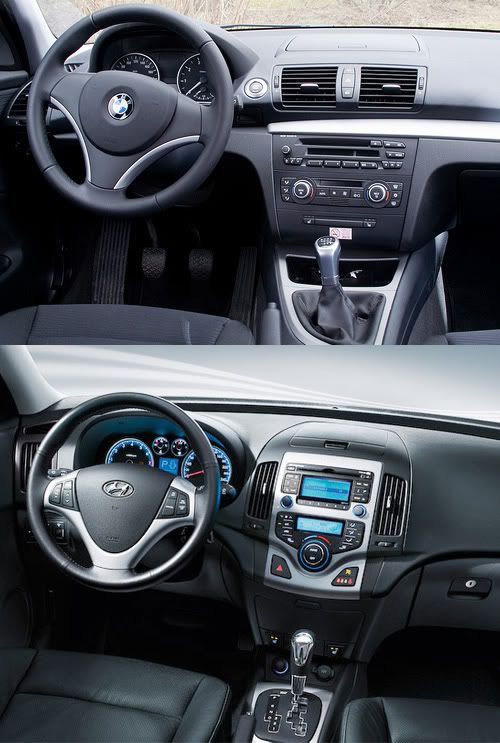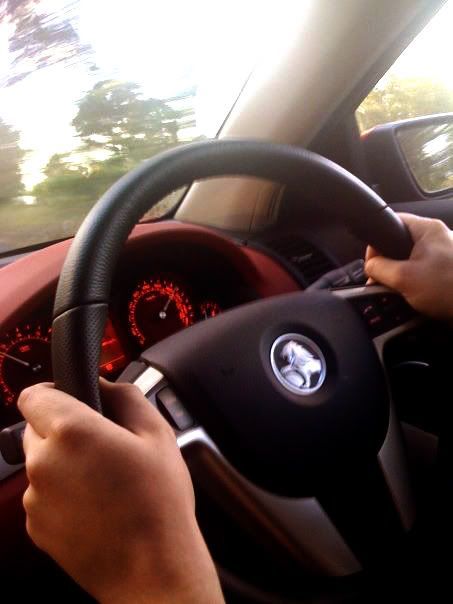skip to main |
skip to sidebar
The E92 335i really didn't whet my whistle. When the first pictures of the E92 were released, I didn't pine over it like I had with the E46. And out of the M3 and Audi S5, BMW would have a hard time to win me over from the lines of Audi's coupe.
The 335i has a brilliant engine, and is a hugely capable car that inspires confidence in anyone who steps behind the wheel. There's nothing mind-blowing about it though, it just does everything as perfectly boring as you'd expect from Germany. Boring is probably the wrong word, but with it's acceleration matching that of an E46 M3, I was expecting something else.
And I found it in the 135i. When I drove it at its release, it became my new favourite car. Well, more accurately, my new favourite daily-driver. If I had one of these to take to work every morning, I would consider moving further away. (For the record, I would still take an E46 M3 for the weekend.)
The 135i is just so nimble, so easy to dip into a corner, so easy to sink the right foot in and let the power improve on your already massive grin. Dropping that engine into the 1 Series is the difference between Clark Kent putting his red togs on and stashing his glasses.
And the convertible somehow makes sense in the 135i. And it’s practical, with seating for three others. Even in the wet with the top up the convertible didn’t concern me in the slightest. I just prayed for five minutes of sun to get a chance to lower the roof.
BMW are marketing their new baby-vert to me, and it's sure as hell working. More than any marketing though, it's the car that is closing the sale. It's just brilliant.
Which brings me to the BMW E89 Z4. This is a car that is placed directly in the sights of middle-aged men the world over. A competitor to the SLK of Mercedes-Benz, the Z4 sDrive35i feels, from a driving perspective anyway, very similar to the E92 335i; albeit slightly more nimble, and with an enclosing cabin that harks back to the original roadsters of the mid-20th century.
With the SLK350, it feels like a big-boy’s toy. Very easy to drive around town, but all in all just a nice little sports car for people who don’t care terribly about driving dynamics. I was a little disappointed with the interior plastics and overall design, but I’m sure it would appeal to some.
A stark contrast to the interior of the much younger Z4. The quality of this interior is the best of any car I’ve ever been in. The perfect mixture of leather-stitching, wood-grain, and aluminium. I can’t imagine anyone experiencing buyer’s remorse when sitting in the cabin of this car.
Then there’s the engine. Surprisingly inaudible with the top down, that 3.0 litre twin-turbo had me turning around and going back through the tunnel just to hear that exhaust brap as the DCT swapped cogs. Just as with the 135i and 335i, this engine is a delight in normal driving circumstances. Turbo lag has almost been eliminated, but not completely. I know it’s not meant to be an M-car, but sometimes when I mash the loud pedal, I want that neck-snapping experience you would get with the old M3 3.2 litre. I am nitpicking, though.
But my most favourite thing about the Z4 was the cruise control. It’s such a revolutionary, intuitive design, my mind boggles as to why no-one has thought to make a cruise control like this in the past 20 years.
Push forward on the stalk and it will lock whatever speed you are currently doing. A little green light on the outside of the speedo (where the speed currently is) shows it has been engaged. Push it forward again, however, and it will bring your speed up to the nearest whole number. For example, if you were doing 76kph, pushing forward twice would bring you to 80kph. Push it again, and it will take you up to 90kph. Pull it back and you’re back doing 80kph.
Finally, a cure to the Monash Freeway road works migraine.
Through a twisty coastal road, the Z4 is a bit of fun. With the hard-top in place, the car feels like a very similar place to the old E85 Z4 Coupe. Well balanced as a coupe, when turned into a roadster, the weight of the E89 Z4 shifts noticeably to the rear of the car. Some would argue that this enhances the old-school roadster experience.

But even with a beautifully sunny day and the hard-top tucked away, I couldn’t really appreciate the sensation of being in a convertible. Because you are so encapsulated within the car, it doesn’t really feel like you’re outside. As a lover of convertibles, it was a little disappointing.
If you feel like you want to turn up the adrenalin in the zed, you can put the DCT into manual mode and turn the suspension setting from Normal to Sport or Sport Plus. As well as sharpening throttle and steering, the latter actually disengages the stability & traction control, making the car a bit skittish – and with it, more fun.
The DCT is a good gearbox. Somehow not as fun as Volkswagen’s DSG, though. And I know it’s been said before, but the paddle system is so counter-intuitive it really discourages any spirited manual driving. Thankfully the gear shifter can still be used. If it were my money, I would opt for the manual gearbox. Slower, maybe, but surely more fun.
Whereas the 135i feels like an MX-5 that has been plugged into a Marshall stack and turned up to maximum volume, the Z4 feels like it was designed for people who think they are a lover of roadsters, but have never actually been in one.
Don’t get me wrong, the new Z4 is a great car. The level of engineering is unbelievably good. The fit and finish is impeccable. But somehow it suffers from the same problem (and I use the word loosely) as the 335i. It’s a quick car that doesn’t really inspire as the old roadsters used to. It's BMW's 135i that really paints a stupid grin on your face, and as such remains my favourite of the current convertibles on sale.
Many thanks to Nick, Russell, and Chris, along with the rest of the team at Mornington BMW for their wonderful help and hospitality at the launch of the Z4. Please visit www.morningtonbmw.com.au to book your test drive.
As I was cursing the peak-hour traffic I was so unfortunately stuck in the other day, my eye was drawn to a BMW E87 116i, glistening black in the afternoon winter sun. And it got me thinking: what defines a luxury car?
While I pondered this question, I realised that it’s far harder to demarcate than I had originally assumed.
There are cars we automatically pigeon-hole as being from a luxury automaker, and those that we assume are simply transport. In the past, it was easy. Luxury meant leather and technology. Today, both are easily accessible, available from even the entry-level Korean offerings.
Take, for example, the Hyundai i30cw. This is a small-to-mid-sized wagon that comes with leather, an optional diesel engine, along with a host of other features, all together in a well-built package that is actually a lot of fun to drive. Combined with an unparalleled warranty, and here you have what is undeniably a great car. But despite being a better vehicle than BMWs 116i, it’s not a luxury car. And the BMW is.

Forgetting the physical experience of luxury, the rest of it is defined by marketing and public relations. How you feel about Apple or Virgin or Lexus is sculpted by their PR departments over many, many years. The fact that Americans see the Infinity G37 as a luxury coupe, rather than a humble Nissan Skyline, is because of modified perception.
In Australia, Lexus is the perfect example. Perpetuated as the thinking man’s crumpet, Toyota has positioned the L badge as a genuine competitor to the Europeans. We all know that the ES300 was a Camry in a tuxedo, but to golfing grandfathers everywhere it’s a luxury sedan without the ostentatious statement of a German saloon.
Without the high quality of their engineering and craftsmanship, I suspect Lexus would have failed as a brand. They don’t have the history to back themselves up and I think only now are they starting to forge their own character.
At a recent design forum by BMW, artist Thomas Demand said that nowadays luxury is more inwardly focussed, rather than outwardly expressed. Modesty was the overriding message. This makes me think of the rise in popularity of apartments converted from warehouses all over the world as an example.
Even without being able to clearly define it, we all know what luxury is. We know it when we are immersed in it, and we know when it’s being faked. It is not just the material, but the quality of the material being used. The fit and finish of our surroundings. The character; the modesty; the heritage. And, of course, the price.
Two years ago the Monash University Accident Research Centre invited me to the launch of Going Solo, a booklet for parents of young people about to embark on independent driving. After enjoying a coffee and some pastries I went down stairs, jumped in the X-Trail, and drove through torrential rain to Mount Buller.
It is absurd, I thought, that young drivers are allowed to drive in these same conditions, on these same roads, without any formal training. The only practical driving test they must be complete is proving to someone they can correctly parallel park. Not confidence inspiring stuff.
The Going Solo booklet was designed to help convince parents to hand the keys to their kids, thus giving them more time and experience on the road. Addressing the problem of overprotective parents was certainly needed. But it’s an indirect solution to the real problem: a fantastic lack of experience in new drivers.
In 2001 the Monash University Accident Research Centre conducted a study on the impact of driver training on young people. Many people incorrectly cite this study as proof that driver training actually increases the likelihood of being involved in a collision due to the confidence that is instilled in the participants. These were not the findings of the study. In fact, the paper found that many people had stopped speeding and tailgating after participating in the training. The study recommended that driver training be considered by road safety experts in the future.
But even as recently as 2007, when I spoke to a senior researcher at MUARC, she held the position that driver training is detrimental to young drivers.
Two months ago a good friend of mine called to tell me that she’d almost had an accident. Driving in heavy rain, Georgia had read the road ahead and prepared herself for someone to do something stupid. Sure enough, a car pulled in front of her, causing her to jump on the anchors, the ABS shuddering through the pedal of her Yaris, and she successfully steered her way around the moron.
For Christmas a friend had bought Georgia a place at the BMW Driver Training day at Phillip Island. She says were it not for that, she would have ploughed into that dickhead; with possibly dire results.
It’s no secret that insurance companies are the safest gamblers you’ll ever find. They base everything they do on well-funded, well-founded research. Know this: many insurance companies lower your premiums if you’ve completed a driver training course. This means that they think you’re less likely to have a crash. If it makes you safer on the road, why isn’t driver training compulsory for new drivers?
The answer is logistics.
Can you imagine – every fresh-faced 18 year old that gets their licence, every day, hundreds of them throughout Australia… How could every one of them possibly take part in a day-long course? It would be a nightmare. I don’t know many driver training companies there are in Australia, but my guess would be not enough.
So the government continues to cite incorrect “evidence” that is also completely out of date, because it sounds better than saying ‘It’s too hard.’
My solution? Introduce driver training as a compulsory subject in senior school.
We have subjects that teach cooking, money management, law, art, computer skillz, sports, media… hell, even English is compulsory. But if you want to be a tradie, not knowing how to correctly insert quotation marks isn’t going to kill you. Not knowing how to brake correctly just might.
Yes, this raises a host of issues and would be hard for schools in remote areas – I’m not saying it won’t present problems – but really, this is about reducing the number of deaths and serious injuries suffered by thousands every year. I’m sure we could work through the hurdles with that promise. I would happily teach kids how to drive, and I know a lot of others that feel the same.
Give me one term with a classroom of year 12 students, and I’ll scare the shit out of them. And not just with my body odour, but with pictures, videos, real-life accounts of car accidents. Have them talk to someone with acquired brain damage. As I said in Part One, there could be excursions out where kids get to see how much damage is caused at 50kph. We could incorporate it with the proposed buy-back scheme for older cars (designed to encourage the sales of newer, safer vehicles) and kill two birds with one stone.
I know this seems like a long shot, but to me, it’s insanity to ignore this issue any longer. At some point we need to stop relying on technology to save us, and start taking responsibility for what is going on.
I’m not really all that masculine.
It’s ok, I accepted this many years ago. I’d head down to the local discotheque of a Saturday night and feel completely out of place amongst all the meat-heads. And it’s not that I felt inferior as a man; I would just rather spend my time perfecting my heel-toe technique than learning how to dance with my crotch.
But despite not being ‘one of the boys’ there really isn’t much that genuinely scares me. Spending my life in a dead-end job scares the hell out of me. A loveless marriage scares me. And car crashes scare me.
I’ve been in quite a few over the years, and almost all as a passenger.
The worst was in of July of 2007. My two best mates and I drove to Stockton Beach north of Sydney to test out the FJ40 Land Cruiser soft-top one of them had just bought. We were driving along the beach just before dawn so we could watch the sunrise at the waters edge before we’d have our day of fun. As we were driving up a slight incline in the dark, we were unaware that the other side of the dune had washed out. We careered over the edge, landing on the nose of the car, and rolling onto the roof. Of course, there was no roof, but luckily there was a roll cage installed. It saved our lives. Incredibly, the cage itself had actually punched through the floor about a foot due to the force of the crash. Still upside-down, my mate grabbed the hanging UHF and shouted for the Land Cruiser that was following us to stop. That was enough for them to jump on the brakes just before they came over the top and hit our nose. And I was trapped in the back for a few minutes drifting in and out of consciousness.

I remember telling my mother, at about the age of 16 and whilst I was driving, that I probably won’t die because of speeding or drifting. I said to her that I thought I would most likely die changing the CD when I was at the wheel.
I still think that’s true. But at that age, I had no real grasp of how to look for an accident. Now I think the biggest contributing factor to the young road toll is that that can’t visualise an accident.
When I’m driving I’m always sub-consciously looking for the worst possible outcome. And it comes from knowing what it’s like to spin out at high speeds; what it feels like to be the ice in a cocktail shaker; and the sound of screetching tyres and metal and glass as they crunch together.
A couple of years ago I was interviewing one of Australia’s leading womanising stuntmen, and he was telling me about a time he took his son out near his farm. He’d picked up an old Volvo, put a helmet on the kid, and taken him down a back road. And then he rolled the car. Purely to show him how easy this was to do.
By the look of his nose, this guy had been in one too many accidents without the proper safety equipment – but his story really struck a chord with me. Why the hell aren’t we crashing our children in cars from a young age?
Driver training centres simulate wet conditions and how to control a car in the event of over or understeer. Why shouldn’t we put them in cars and roll them? Or drive them into a wall at 40kph? I swear to God, this would have a genuine effect on the road toll.
Not only would young people love being strapped into a car and crashed, they would realise the fine line between being in control, and not. Realistically, you wouldn’t have to put them in the car. Put them a safe distance away and let them watch the carnage.
There really aren’t many things that scare me. But being a passenger in the car of a young driver scares the shit out of me.
I have a depressed friend.
The other night we started talking about what makes us happy. Not just happy, but when we are at our happiest.
Sitting – as I did just last night – at a pokey little jazz club in my beloved Melbourne, surrounded by friends, amazingly talented musicians, and complimented with a good glass of red was high on the list.
Curled up on the couch with a warm girl (yes, girl) under a blanket, watching DVDs next to a roaring open fire as the rain washes against the window – again, this was pretty high up there.
Also on my list was something that I’ve been lucky enough to experience more than once in my life. A beautifully bright, sunny day, coupled with a fast car (convertible or open sunroof, please) and a winding road next to the sea. Add to that a CD of some shameless house music or happy drum & bass, and life couldn’t be better.
There are some other things on the list that I’ll spare you, as I’m sure you can imagine what most guys my age want.
Everyone seems to be searching for happiness in this life. And I think they’re missing the point.
Of course you should be striving for happiness, but the problem is most wouldn’t know how to define it. For me, happiness is freedom and happiness is friends. And a good soundtrack to go with whatever we’re doing.
A good friend of mine, Pinstripe, has a similar outlook on life. Despite his strange fetish with French cars (francautomania), we spend most of our time together discussing what cars we should give a home to.
He’s a bit of a traditionalist. For him, a car must handle like it’s about to go compete at the Mt Buller Sprint. It must be powerful enough to eat almost anything at the Dandy drags. And it has to make a statement.
His list of cars reads like the contents page of Fast Fours, with a few turbo sixes and a V8 thrown in for good measure. Like many of our loyal readers, stepping out of the elevator and walking to his car fills him with joy. And like those same readers, nothing can compare with driving that car on a mountain road in the dead of the night.
Luckily for us, Pinstripe is the latest contributor to Track Shun. I hope you enjoy his love of all things fast as much as I do.
Fellow Australians, we do truly live in the lucky country.
Incredible sun-drenched beaches; fantastic restaurants, cafes, and chic shopping precincts; and roads that can match any of the finest routes you’ll find overseas (in fun – not quality).
And for less than $5,000 you can buy a ten-year-old, rear wheel drive sedan with a big six-pack up the front. Seriously, what more could you want?
Well, if we’re talking about the Ford AU Falcon, then the answer is almost anything else.
But in the case of the VT Commodore, or for a few bucks more, the BA Falcon, you’ll be getting some pretty honest cars. In between them, you’ll find hundreds of model variants to suit almost any body. (Unless you need something small or fuel economical.)
Such choice. We are spoilt with our Australian model range. Wagons, utes, limousines, soft-roaders, performance cars, and even a coupe in the case of the Monaro. V6s, superchargers, turbochargers, LP gas options, or big muscular V8s. Diesels and hybrids are also rumoured to be on their way for the local manufacturers.
With this much choice, there is a strong culture of patriotism to our local car industry. Which is both good and bad.
We need this car industry, not only for our economy, but because it is one of the few truly unique products that we compete well at on the world stage. Our Commodore is rebadged as a Chevrolet Omega in the Middle East, as a Vauxhall VXR8 in the UK, and, until the collapse of the brand a few of weeks ago, as a Pontiac G8 in the US. And with each release in these parts of the world there came rave reviews.
But don’t try and tell me that a Statesman is equal to an S-Class, a Territory is as good as an XC90, or a GTS is on par with an M5. Australian cars have come a long way, massively so in the last fifteen years, but they’re still a long way off competing with the Europeans.
Which is why I can’t understand this reverse elitism that exists amongst Australian car owners. There is a strong sense of smugness that I’ve noticed in our local car community. And it’s an attitude being led by our local automotive media.
Sure, we should be proud of what we produce, but we don’t yet have the driving dynamics of the Germans’, the reliability of the Japanese, or the chic style of the French. Ok, so I was joking that last one. The French actually posses the same smugness we have here: Their cars are good, but they simply aren’t as good as they think they are.
When the VE Commodore was released in 2006 it was touted as Holden’s Billion Dollar Baby. Local motoring journalists spewed out claims that this was our local industry’s answer to German cars. They told us that the VE had the build quality of an Audi and held the road like a BMW.
Naturally, my anticipation grew with my rising expectations.
So when my turn finally came to drive the VE, I was genuinely impressed. And I was surprised I was impressed. I thought the 1997 VT was a massive leap over the VS, and that this VE made a similar jump from the outdated VZ.
That same day I drove the recently released BMW E60 530d; an absolutely brilliant, perfect car. Not only did it help to kick-start my love affair with modern diesels, it confirmed what I had previously suspected: the VE was not on the same level as the Germans. And at around one-third of the price, it shouldn’t be expected to be, either.
I think the VE is good value for money. If you’re not paying the bills, then the SS is a tremendously fun machine with an addictive, ballsy torque curve – which is less like a curve than a thick straight line. And in wagon trim, it’s even cooler.

But towards its limits, the Commodore still handles like it’s carrying cement both ahead of the steering wheels and behind the driving ones. The seats are more like Lay-Z-Boys, the plastics are hard and brittle, the buttons feel unrefined, and the equipment levels are the bare minimum of what is expected in a modern vehicle.
Remembering the VE cost Holden one billion dollars, the new FG Falcon cost around half a billion dollars to build. Does this mean that Ford skimped, or does it mean that Holden spent their money in a zealous manner? Well, the Ford certainly isn’t half the car of the Commodore, so it’s probably more of a latter.
Every time though, it comes back to price; and more importantly, value. If you’re looking for space, it’s hard to go past the VE Commodore or the FG Falcon. And sure, they make quick cars, imitation luxury cars, and a host of other variants, but don’t think that you’re buying anything more than what it is.
We’re lucky that we have an industry that builds uniquely Australian cars, and proudly exports them overseas. But as far as the fit, finish, and road holding of our cars are concerned, we still have a long way to go before we have a car that is truly and honestly of a world class.
There is a question I’m constantly asked. Almost without fail, when a car apathist enquires as to how much I’ve just spent on an upgrade, or the price of my next car, they ask:
“How can you justify spending that much?”
My answer is always the same. If I were really into fishing I would own many fishing rods. Some made out of carbon-fibre, some designed to get one type of fish or another. I would spend $2,000 on a fishing rod without blinking because fishing is what I get pleasure from.
But I’m not into fishing. I’m into driving. I love cars and the pleasures they evoke when I drive them. So I spend lots of my money on cars.
Generally, they’ll nod, respond with “fair enough,” and walk away to do something non-car related.
For my friends and I, spending money on our cars is perfectly justified. They are a giant blank canvas for which we can change and manipulate in order to represent ourselves. By sliding into the driver’s seat of a car, you are more or less putting on another set of clothes. To us, it can be the difference between Fubu and Armani.
Anyone who knows anything about fashion realises that putting on an expensive garment isn’t about showing off. Of course, that element is always a part of it, but it’s more about the quality of the material, the manufacture, and the fit. Primarily, though, it’s about how you feel when you put it on.
A car is no different. What type of car you drive says a lot about you. A modified car, and how it is modified, says so much more.
Take for example the Toyota Corolla – the standard by which all other small cars are compared. Most believe it to be a perfectly uninspiring and inoffensive vehicle, and they’d be right. Until you realise that the Corolla badge has a history steeped in performance.
Since it was first introduced in 1966 the standard run-of-the-mill Corolla has been accompanied by its performance stable mate: the Sprinter. Originally a sport-back coupe (not to be confused with the sport-back moniker used to identify wagons nowadays), the Sprinter was sold as the slightly sexier, slightly more desirable, sometimes faster variant. Over the years there have been a number of changes to the performance name, but the idea has never changed.
Arguably the best known of the Sprinters is the AE86. Most people wouldn’t even realise it was actually a Corolla. A sleek fast-back (hatch coupe) with a north-south 16-valve 1.6 litre 4AGE, the AE86 is the spiritual forefather of drifting. The featherweight rear-wheel-drive proved that, just like its predecessors before and its successors thereafter, you don’t need high horsepower to successfully compete on (or off) the track.
In 2003 the ninth generation Corolla was released; and with it, the Sportivo – the reinvention of the old Sprinter nameplate.
And here we have one of the most underrated, unassuming performance hatches on our roads. Chosen by Lotus to be used in their Elise and Exige models, the Sportivo enjoyed a 141kw 1.8 litre engine mated to a 6-speed manual gearbox. Granted, this was a damn expensive vehicle from new when compared with others, even with standard leather. But despite the famous Corolla depreciation (or lack thereof) the Sportivo remains one of the best-value hot hatches in the used car market.
Allow me to introduce Blind Kid Seeks, Track Shun’s latest contributor. His stark white Toyota Corolla Sportivo, riding on black multi-spoke wheels with subtle eyelids says a lot about who he is. Unlike your typical ricer hatch, his is a very clean vehicle. One that speaks directly to other enthusiasts.
BKS will give another perspective to the joys of driving, particularly in the areas I have little authority to speak on – that of spirited front-wheel-driving. As someone who works in the fashion industry and is always up with the latest trends, perhaps his car speaks more about his persona than most. Like a clean-cut Calvin Klein suit, it is maybe not the first thing traditionalists think of, but it’s very well respected by those in the know.
Despite our five year gap, my big brother and I share very similar tastes. I bought my first Linx Java when I was ten after I discovered his can of Java. I watched the shows he loved, and hated the shows he hated. I even stole his dinner recipes to impress girls. So when I became old enough to form opinions of my own, I started to listen to what my heart really longed for.And from that came two major differences between us: He likes films; I like cars. He likes mint chocolate; and I don’t so much. My brother likes movies probably about as much as I like driving. I love the cinema too, but I just like driving that little bit more. In the same way that you like both movies and driving, but you just prefer bourbon and porn.You see, in a cinema you can sit back and for 80 minutes you forget about your bills, forget your chores, and give yourself to the director. You allow yourself to be taken from your world. And if the director is any good they will capture your attention and play with your emotions. They will stimulate your senses. Even touch, depending on how good the subwoofer is.It’s not a big jump to find parallels between a cinema experience and driving. And I’m not talking about popping down the shops in your mum’s Festiva. I mean real driving. The type of driving that most people haven’t genuinely experienced, and therefore assume people who are ‘into’ driving need a testicle removed.Real driving. Just like in a cinema, you sit in a big hugging seat with surround sound and a big screen in front of you. But there is something more, I think. In the right car, on the right road, every sense is electrified. Being able to feel, through every part of your body, that you’re pushing the limits of what is physically possible. In the right car, on the right road, at the right time, you can experience the same sort of escapism that films, bourbon, and illicit drugs provide. Imagine a winding piece of blacktop, with a fatal drop to your left and a wall of rock to your right. Your windows are down, so you can better hear the howl from the exhaust as you accelerate out of the corner. Hitting four and a half grand in third, you push hard into the brake, blipping the accelerator with your heel as you punch the clutch and grab second, holding the wheel with your right hand as it fights against you. Off the brakes, the car dives into the corner, your right foot applying pressure to the throttle as you touch your first apex; second apex; the front tyres scrambling to maintain grip. You see your exit line and open the throttle, getting ready to set the car up for the next series of corners.It’s like a movie, but instead, you’re the star. You’re not watching someone else experience the adventure. It’s you that is in control.There’s also an argument that you’re far less likely to die in a cinema than you are pushing a car to its limits on a winding road. Which is fair enough. Some nights I just want to lie on the couch and watch someone else play with danger as I eat the cold popcorn that slid down the side of the couch.But there is a certain something about spirited driving that I don’t experience anywhere else. A roller coaster gives a similar rush, but not in the same way. You know what to expect as you’ve watched it go around two dozen times as you waited in the line, and you’re not responsible for the consequences should something go wrong. Unless you’ve decided to eat a dodgy hot dog from that Bedford van around the corner before you lined up. I think it’s unfortunate that the line has blurred between people who love cars, and those who love driving. Granted, most people who love driving also love cars, but it’s not always the other way around. Cars with four-pots mated to autos and wearing 21” chromies is a testament to that. Which is partially why I’ve created Track Shun. The majority of editorials and car blogs focus on the current state of the automotive industry and on new car releases, and very few talk about the love of that driving experience. Of course, I’ll be talking about the industry and new cars, too, but it’ll be smarter and funnier. Probably the biggest similarity between my brother and myself is that we are both very passionate about the things we love. And seeing as Top Gear Australia decided not to hire me, this blog will have to do.






